Page 298 of 598
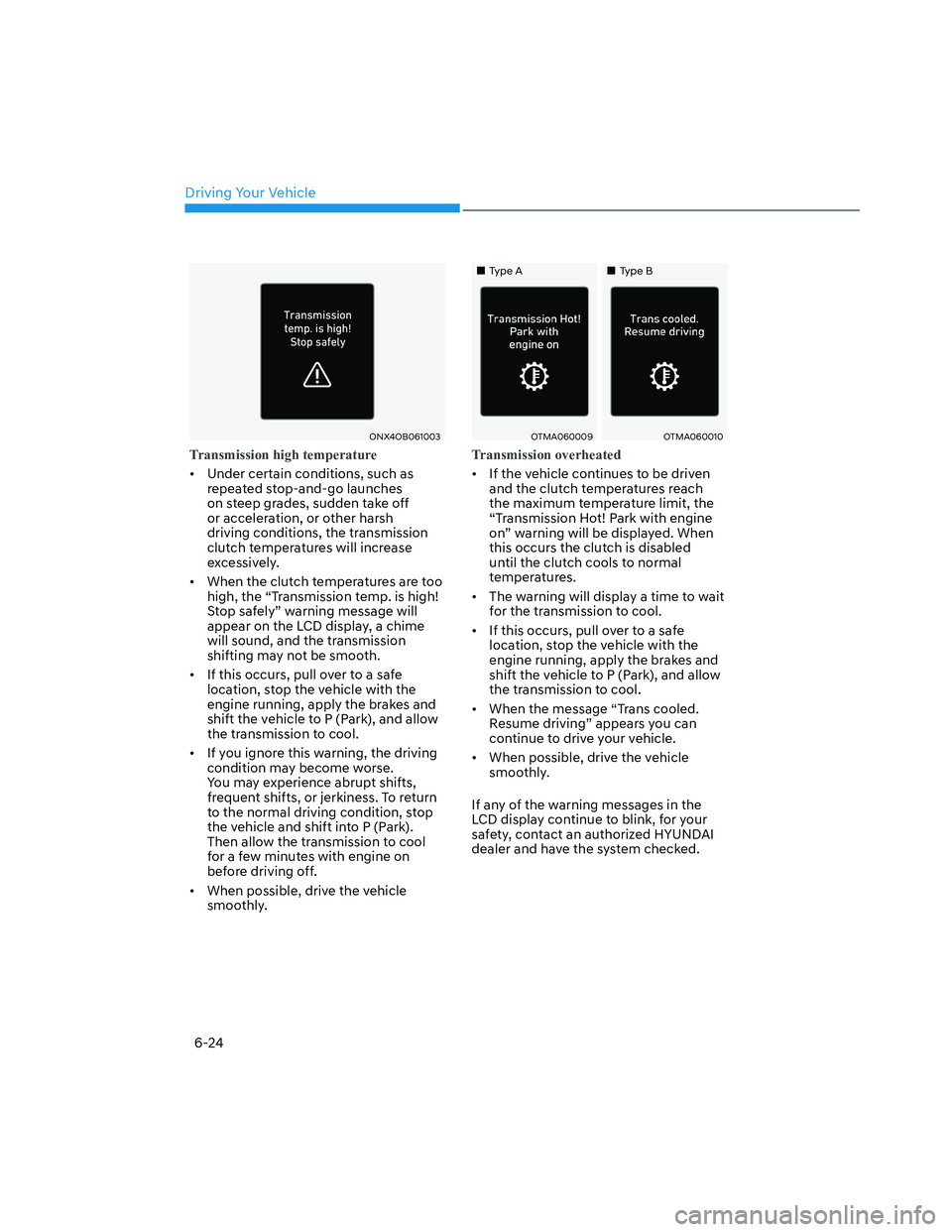
Driving Your Vehicle
6-24
ONX4OB061003ONX4OB061003
Transmission high temperature
• Under certain conditions, such as
repeated stop-and-go launches
on steep grades, sudden take off
or acceleration, or other harsh
driving conditions, the transmission
clutch temperatures will increase
excessively.
• When the clutch temperatures are too
high, the “Transmission temp. is high!
Stop safely” warning message will
appear on the LCD display, a chime
will sound, and the transmission
shifting may not be smooth.
• If this occurs, pull over to a safe
location, stop the vehicle with the
engine running, apply the brakes and
shift the vehicle to P (Park), and allow
the transmission to cool.
• If you ignore this warning, the driving
condition may become worse.
You may experience abrupt shifts,
frequent shifts, or jerkiness. To return
to the normal driving condition, stop
the vehicle and shift into P (Park).
Then allow the transmission to cool
for a few minutes with engine on
before driving off.
• When possible, drive the vehicle
smoothly.
�����„�„Type AType A�����„�„Type BType B
OTMA060009OTMA060009OTMA060010OTMA060010
Transmission overheated
• If the vehicle continues to be driven
and the clutch temperatures reach
the maximum temperature limit, the
“Transmission Hot! Park with engine
on” warning will be displayed. When
this occurs the clutch is disabled
until the clutch cools to normal
temperatures.
• The warning will display a time to wait
for the transmission to cool.
• If this occurs, pull over to a safe
location, stop the vehicle with the
engine running, apply the brakes and
shift the vehicle to P (Park), and allow
the transmission to cool.
• When the message “Trans cooled.
Resume driving” appears you can
continue to drive your vehicle.
• When possible, drive the vehicle
smoothly.
If any of the warning messages in the
LCD display continue to blink, for your
safety, contact an authorized HYUNDAI
dealer and have the system checked.
Page 299 of 598
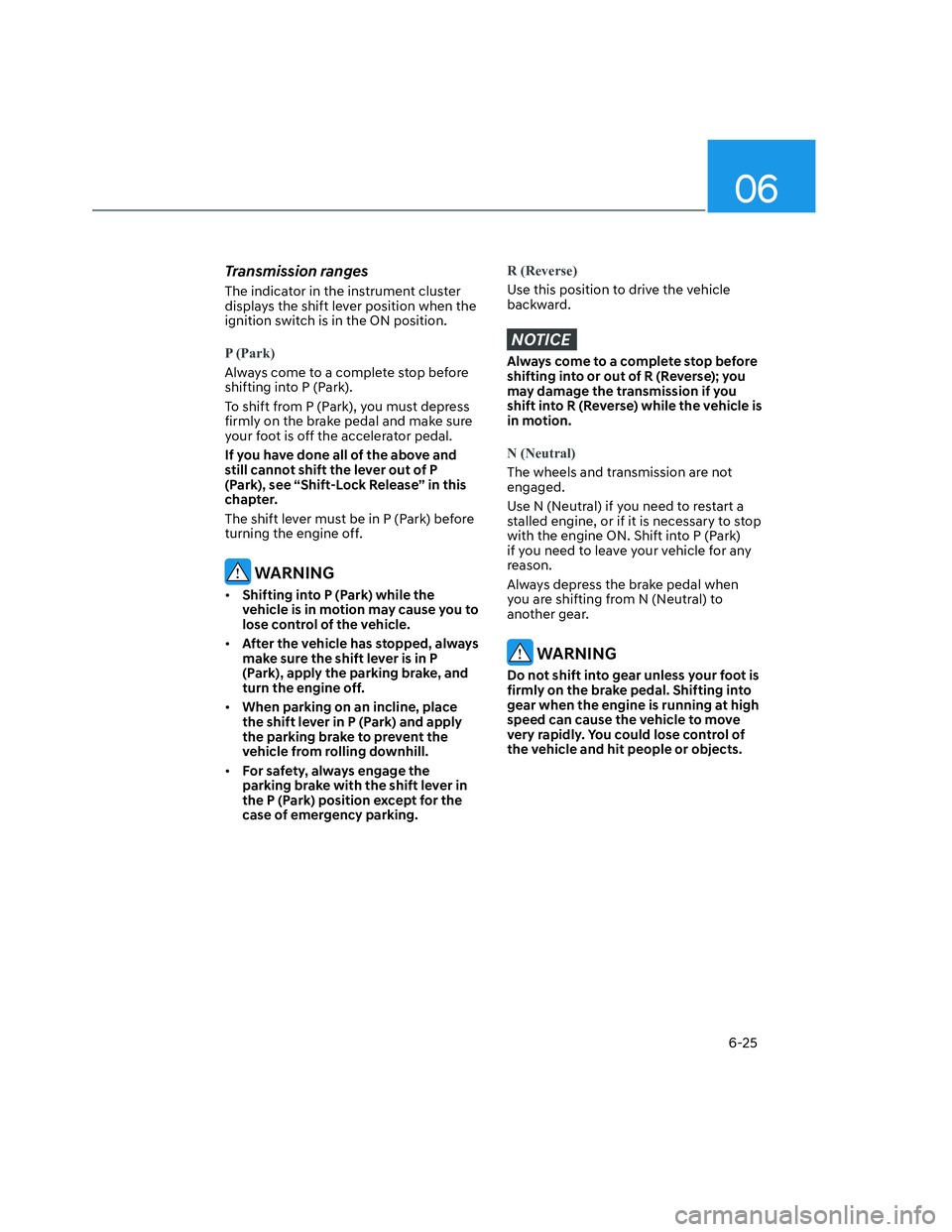
06
6-25
Transmission ranges
The indicator in the instrument cluster
displays the shift lever position when the
ignition switch is in the ON position.
P (Park)
Always come to a complete stop before
shifting into P (Park).
To shift from P (Park), you must depress
firmly on the brake pedal and make sure
your foot is off the accelerator pedal.
If you have done all of the above and
still cannot shift the lever out of P
(Park), see “Shift-Lock Release” in this
chapter.
The shift lever must be in P (Park) before
turning the engine off.
WARNING
• Shifting into P (Park) while the
vehicle is in motion may cause you to
lose control of the vehicle.
• After the vehicle has stopped, always
make sure the shift lever is in P
(Park), apply the parking brake, and
turn the engine off.
• When parking on an incline, place
the shift lever in P (Park) and apply
the parking brake to prevent the
vehicle from rolling downhill.
• For safety, always engage the
parking brake with the shift lever in
the P (Park) position except for the
case of emergency parking.
R (Reverse)
Use this position to drive the vehicle
backward.
NOTICE
Always come to a complete stop before
shifting into or out of R (Reverse); you
may damage the transmission if you
shift into R (Reverse) while the vehicle is
in motion.
N (Neutral)
The wheels and transmission are not
engaged.
Use N (Neutral) if you need to restart a
stalled engine, or if it is necessary to stop
with the engine ON. Shift into P (Park)
if you need to leave your vehicle for any
reason.
Always depress the brake pedal when
you are shifting from N (Neutral) to
another gear.
WARNING
Do not shift into gear unless your foot is
firmly on the brake pedal. Shifting into
gear when the engine is running at high
speed can cause the vehicle to move
very rapidly. You could lose control of
the vehicle and hit people or objects.
Page 311 of 598
06
6-37
Warning messages
ONX4OB061007ONX4OB061007
Parking brake automatically engaged
When EPB is applied while Auto Hold
is activated, a warning will sound and a
message will appear.
OJX1069035LOJX1069035L
Press brake pedal to deactivate AUTO
HOLD
If you did not apply the brake pedal when
you release Auto Hold by pressing the
AUTO HOLD switch, a warning will sound
and a message will appear.
ONX4OB061010ONX4OB061010
AUTO HOLD conditions not met.
Close door and hood.
When you press the AUTO HOLD switch,
if the driver's door and engine hood are
not closed, a warning will sound and a
message will appear on the cluster LCD
display.
Press the AUTO HOLD switch after
closing the driver's door and hood.
Page 315 of 598
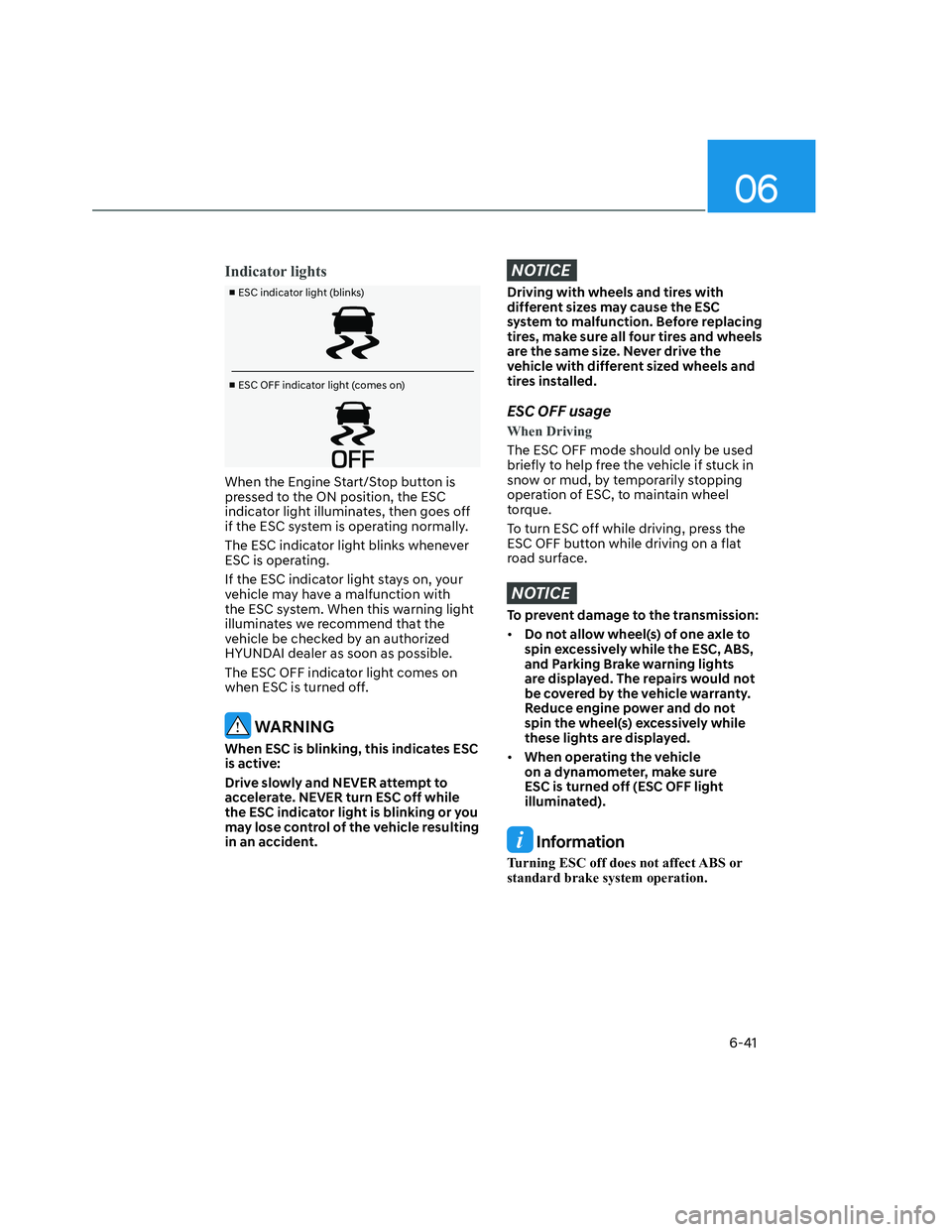
06
6-41
Indicator lights
�v
ESC indicator light (blinks)
�v
ESC OFF indicator light (comes on)
When the Engine Start/Stop button is
pressed to the ON position, the ESC
indicator light illuminates, then goes off
if the ESC system is operating normally.
The ESC indicator light blinks whenever
ESC is operating.
If the ESC indicator light stays on, your
vehicle may have a malfunction with
the ESC system. When this warning light
illuminates we recommend that the
vehicle be checked by an authorized
HYUNDAI dealer as soon as possible.
The ESC OFF indicator light comes on
when ESC is turned off.
WARNING
When ESC is blinking, this indicates ESC
is active:
Drive slowly and NEVER attempt to
accelerate. NEVER turn ESC off while
the ESC indicator light is blinking or you
may lose control of the vehicle resulting
in an accident.
NOTICE
Driving with wheels and tires with
different sizes may cause the ESC
system to malfunction. Before replacing
tires, make sure all four tires and wheels
are the same size. Never drive the
vehicle with different sized wheels and
tires installed.
ESC OFF usage
When Driving
The ESC OFF mode should only be used
briefly to help free the vehicle if stuck in
snow or mud, by temporarily stopping
operation of ESC, to maintain wheel
torque.
To turn ESC off while driving, press the
ESC OFF button while driving on a flat
road surface.
NOTICE
To prevent damage to the transmission:
• Do not allow wheel(s) of one axle to
spin excessively while the ESC, ABS,
and Parking Brake warning lights
are displayed. The repairs would not
be covered by the vehicle warranty.
Reduce engine power and do not
spin the wheel(s) excessively while
these lights are displayed.
• When operating the vehicle
on a dynamometer, make sure
ESC is turned off (ESC OFF light
illuminated).
Information
Turning ESC off does not affect ABS or
standard brake system operation.
Page 320 of 598
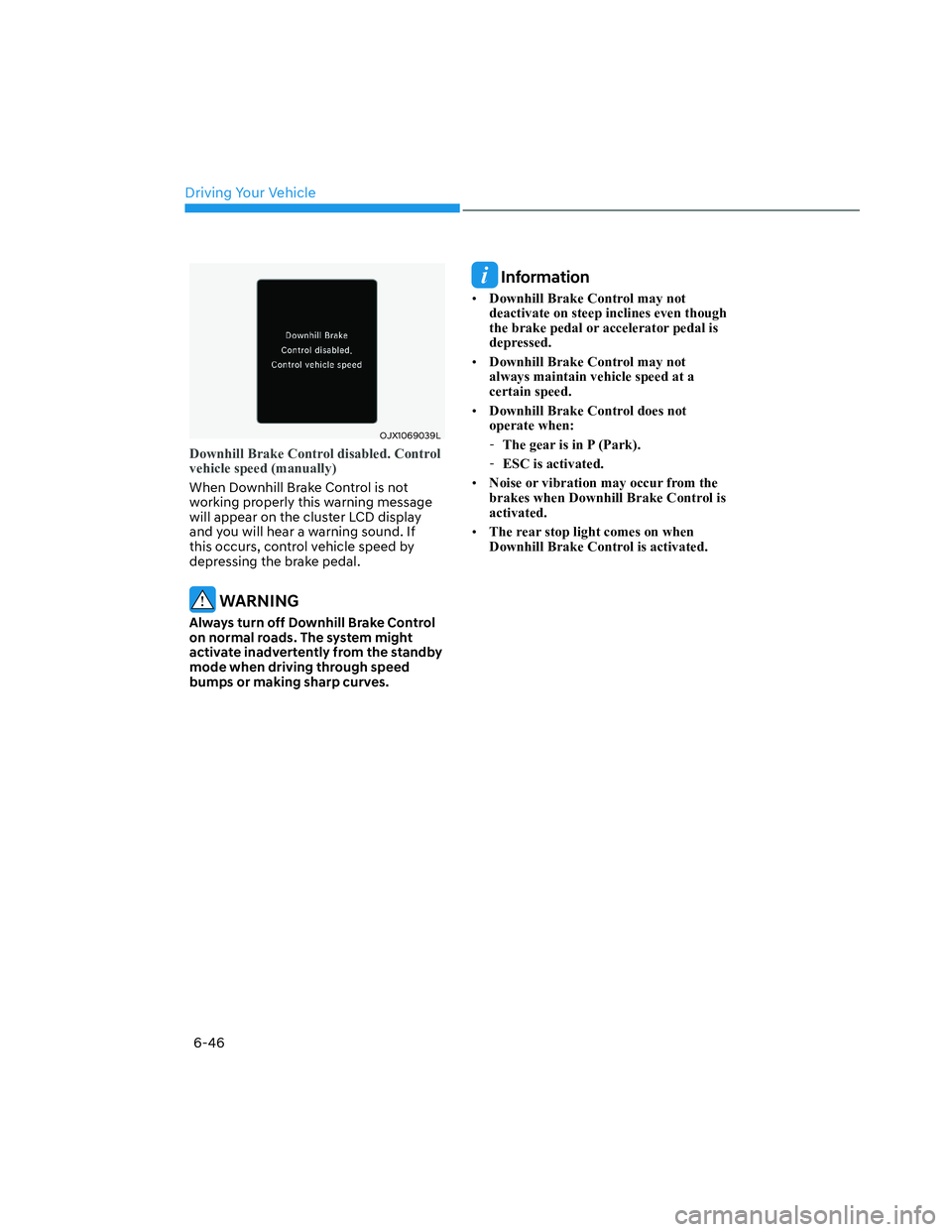
Driving Your Vehicle
6-46
OJX1069039LOJX1069039L
Downhill Brake Control disabled. Control
vehicle speed (manually)
When Downhill Brake Control is not
working properly this warning message
will appear on the cluster LCD display
and you will hear a warning sound. If
this occurs, control vehicle speed by
depressing the brake pedal.
WARNING
Always turn off Downhill Brake Control
on normal roads. The system might
activate inadvertently from the standby
mode when driving through speed
bumps or making sharp curves.
Information
• Downhill Brake Control may not
deactivate on steep inclines even though
the brake pedal or accelerator pedal is
depressed.
• Downhill Brake Control may not
always maintain vehicle speed at a
certain speed.
• Downhill Brake Control does not
operate when:
-The gear is in P (Park).
-ESC is activated.
• Noise or vibration may occur from the
brakes when Downhill Brake Control is
activated.
• The rear stop light comes on when
Downhill Brake Control is activated.
Page 322 of 598
Driving Your Vehicle
6-48
DRIVE MODE INTEGRATED CONTROL SYSTEM
ONX4OB061013ONX4OB061013
The drive mode may be selected
according to the driver’s preference or
road condition.
The system resets to be in the NORMAL
mode, when the engine is restarted.
Information
If there is a problem with the instrument
cluster, the drive mode will be in
NORMAL mode and may not change to
SPORT mode. The mode changes, as below, whenever
the DRIVE MODE button is pressed or
toggled.
NORMAL �< SPORT �< SMART �< SNOW
(AWD)
NORMAL - SPORT – SMART (2WD)
NORMAL mode
In NORMAL mode the engine
andtransmission control logic
worktogether to provide regular daily
drivingperformance with some fuel
efficiency.
• When NORMAL mode is selected,
it is not displayed on the instrument
cluster.
Page 326 of 598
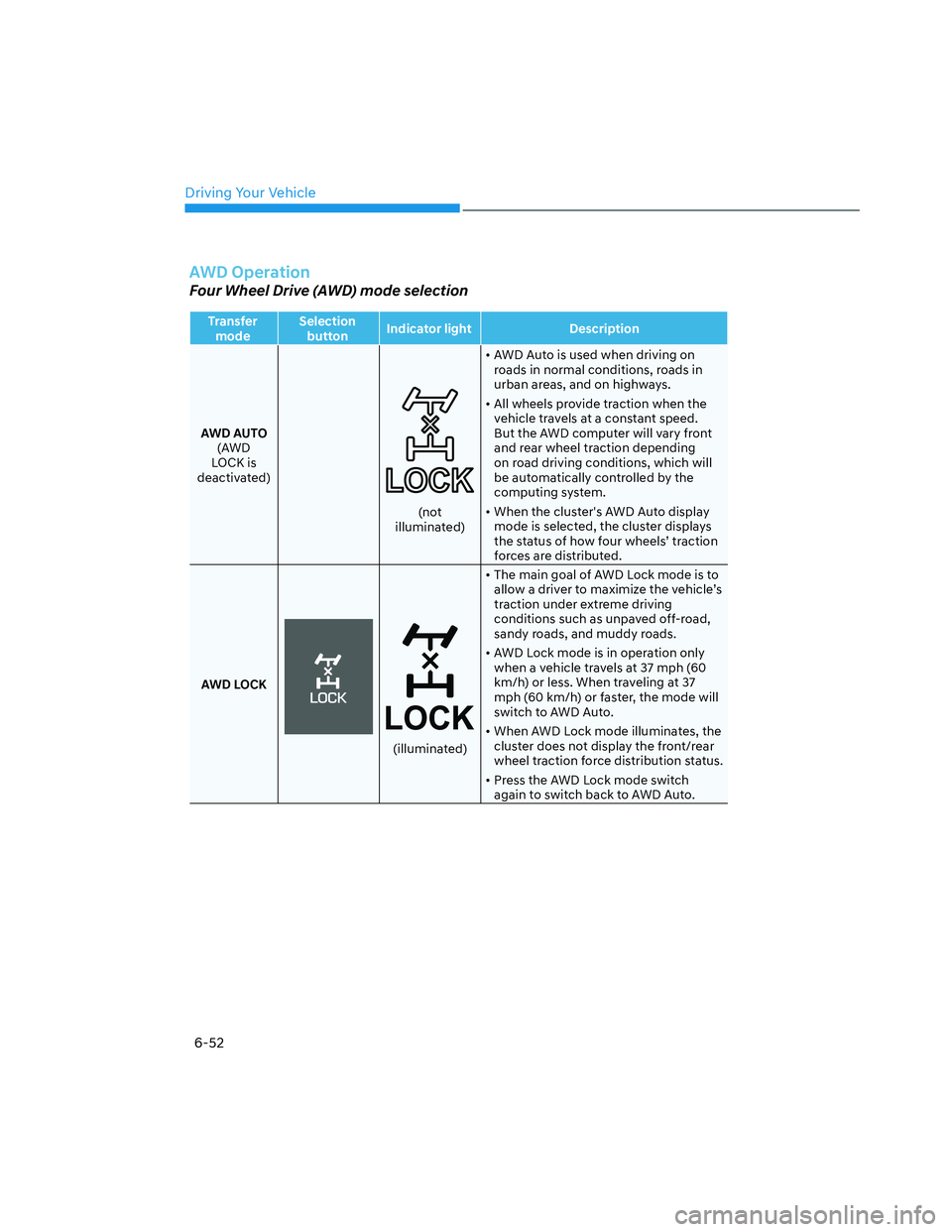
Driving Your Vehicle
6-52
AWD Operation
Four Wheel Drive (AWD) mode selection
Transfer
modeSelection
buttonIndicator light Description
AWD AUTO
(AWD
LOCK is
deactivated)
(not
illuminated)• AWD Auto is used when driving on
roads in normal conditions, roads in
urban areas, and on highways.
• All wheels provide traction when the
vehicle travels at a constant speed.
But the AWD computer will vary front
and rear wheel traction depending
on road driving conditions, which will
be automatically controlled by the
computing system.
•
When the cluster's AWD Auto display
mode is selected, the cluster displays
the status of how four wheels’ traction
forces are distributed.
AWD LOCK
(illuminated)• The main goal of AWD Lock mode is to
allow a driver to maximize the vehicle’s
traction under extreme driving
conditions such as unpaved off-road,
sandy roads, and muddy roads.
• AWD Lock mode is in operation only
when a vehicle travels at 37 mph (60
km/h) or less. When traveling at 37
mph (60 km/h) or faster, the mode will
switch to AWD Auto.
• When AWD Lock mode illuminates, the
cluster does not display the front/rear
wheel traction force distribution status.
• Press the AWD Lock mode switch
again to switch back to AWD Auto.
Page 357 of 598
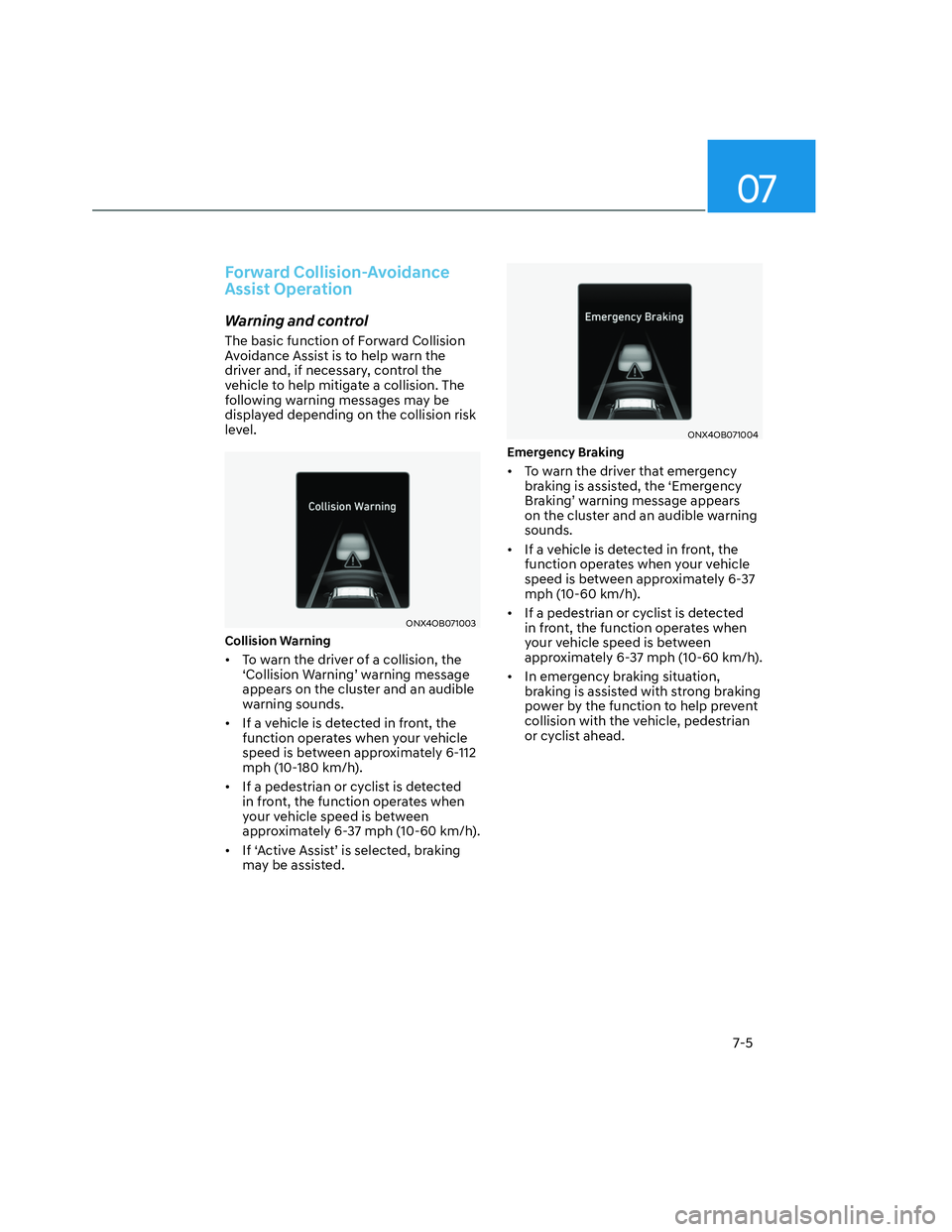
07
7-5
Forward Collision-Avoidance
Assist Operation
Warning and control
The basic function of Forward Collision
Avoidance Assist is to help warn the
driver and, if necessary, control the
vehicle to help mitigate a collision. The
following warning messages may be
displayed depending on the collision risk
level.
ONX4OB071003ONX4OB071003
Collision Warning
• To warn the driver of a collision, the
‘Collision Warning’ warning message
appears on the cluster and an audible
warning sounds.
• If a vehicle is detected in front, the
function operates when your vehicle
speed is between approximately 6-112
mph (10-180 km/h).
• If a pedestrian or cyclist is detected
in front, the function operates when
your vehicle speed is between
approximately 6-37 mph (10-60 km/h).
• If ‘Active Assist’ is selected, braking
may be assisted.
ONX4OB071004ONX4OB071004
Emergency Braking
• To warn the driver that emergency
braking is assisted, the ‘Emergency
Braking’ warning message appears
on the cluster and an audible warning
sounds.
• If a vehicle is detected in front, the
function operates when your vehicle
speed is between approximately 6-37
mph (10-60 km/h).
• If a pedestrian or cyclist is detected
in front, the function operates when
your vehicle speed is between
approximately 6-37 mph (10-60 km/h).
• In emergency braking situation,
braking is assisted with strong braking
power by the function to help prevent
collision with the vehicle, pedestrian
or cyclist ahead.